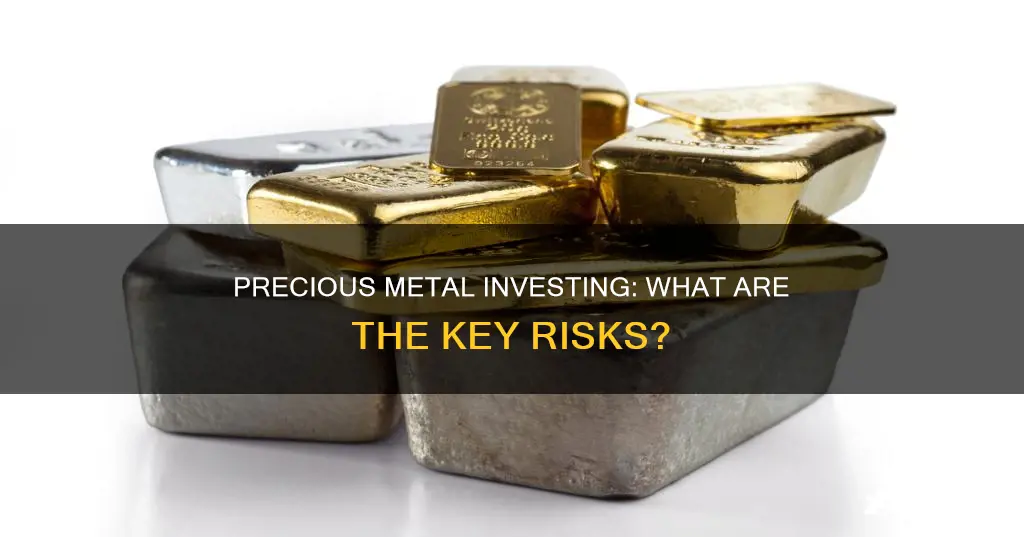
Investing in precious metals such as gold, silver, and platinum can be a lucrative opportunity to diversify your portfolio and hedge against inflation. However, like any investment, it's essential to understand the associated risks. One of the primary risks is market volatility, which can cause the value of precious metals to fluctuate due to economic indicators, geopolitical tensions, and investor sentiment. This volatility can lead to price decreases and potential losses. Currency risk, or exchange rate risk, is another factor, as the value of precious metals is typically expressed in US dollars, and fluctuations between currencies can impact your investment. Liquidity risk is also a consideration, as selling physical precious metals can be challenging during economic crises or market turbulence. Additionally, storage and security of physical metals can be costly and challenging, and there is always the risk of fraud or scams in the precious metals market. Before investing, it's crucial to understand your risk tolerance, conduct due diligence, and carefully assess your investment objectives and market conditions.
What You'll Learn
- Price-related risks: Market fluctuations can affect profitability, despite consistent value
- Trading interruptions: Disruptions can cause price shifts when trading resumes
- Storage costs: Physical storage can be challenging and costly
- Liquidity risk: Selling physical metals can be difficult during economic crises
- Identity theft: Online investments carry the risk of identity theft

Price-related risks: Market fluctuations can affect profitability, despite consistent value
Price-related risks of investing in precious metals
Despite the consistent value of precious metals, market fluctuations can affect profitability. The price development of precious metals depends on market movements, and their value can fluctuate. For example, gold and silver prices can be influenced by economic indicators, geopolitical tensions, and investor sentiment.
Precious metals are commodities, and their prices can fluctuate dramatically. The value of precious metals is expressed and traded in US dollars worldwide. Therefore, for investors purchasing in other currencies, the value of their investment is influenced by exchange rate effects. An appreciation of the US dollar has a positive effect, while depreciation has a negative impact.
Gold and silver prices tend to move inversely with the economy. If the stock market is performing well, gold and silver prices are usually down, and vice versa. During a serious stock market crisis, the demand for precious metals as a safe haven can increase their value.
Precious metals are also influenced by industrial demand, which can fluctuate based on economic conditions and technological advancements. For example, platinum prices are heavily influenced by demand in the automotive industry for catalytic converters.
Additionally, investors should be cautious of "shell" mining companies, which raise investor funds for fraudulent purposes without conducting any actual mining operations. These companies can pose significant risks to investors, as they are not engaged in legitimate mining activities.
International Equity: Diversify Your Portfolio, Grow Your Wealth
You may want to see also

Trading interruptions: Disruptions can cause price shifts when trading resumes
Trading interruptions can significantly impact the price of precious metals. This is due to the complex and lengthy supply chains involved in mining and smelting. For instance, interruptions in production at major mining sites can be prolonged, and new sources of supply cannot be quickly introduced. This can lead to a disruption in the equilibrium of supply and demand, causing price shifts.
The supply of precious metals is vulnerable to various factors, including weather conditions, labour disputes, natural disasters, and geopolitical events. For example, palladium production is primarily concentrated in Russia and South Africa, and a disruption in supply from one of these key producers could place significant pressure on the market, driving prices upwards.
Additionally, the prices of precious metals are influenced by fluctuations in the value of the US dollar, as they are typically priced and traded in dollars. Changes in the dollar's value can impact precious metal prices, further exacerbating price shifts following trading interruptions.
It is important for investors to be aware of these potential disruptions and their impact on precious metal prices to make informed investment decisions. Diversifying their portfolios by investing in multiple precious metals can also help mitigate the risks associated with trading interruptions.
Overall, while precious metals can be a wise investment choice due to their rarity and intrinsic value, investors should carefully consider the potential risks and disruptions that can affect their prices.
Savings vs Investments: What's the Real Difference?
You may want to see also

Storage costs: Physical storage can be challenging and costly
One of the biggest challenges of investing in precious metals is finding a secure and affordable place to store them. If you buy physical bullion, you will need to consider the costs of storing and insuring your assets.
There are several options for storing precious metals, each with its own advantages and drawbacks. Some investors choose to store their metals at home in a private safe. While this option offers easy access to your assets, it also exposes you to the risk of burglary and natural disasters. Additionally, depending on the quantity of metals you own, storing them at home may be impractical due to space constraints.
A safer alternative is to utilise a safe deposit box or a private bank vault in a reliable financial institution. This option provides better security for your investments, protecting them from theft and loss. However, it is important to note that some depositories may charge a percentage of the value of the stored bullion as storage fees, which can be substantial depending on the quantity of metals stored.
Another option is to use the services of professional metal depositories, which offer segregated (private) and allocated (shared) storage options. These depositories typically charge a percentage of the value of the stored metals, which can range from 0.5% to 1% per year, in addition to a minimum monthly or annual fee. While this option can be more expensive, it ensures optimal storage conditions that prevent the oxidation and tarnishing of precious metals.
It is worth noting that the storage costs for silver may be higher compared to gold since silver has a much lower value per weight unit. Therefore, investors should carefully consider the potential storage costs before investing in precious metals, as these ongoing expenses can impact the overall profitability of the investment.
Build a Secure Investment Portfolio Through Duration Matching
You may want to see also

Liquidity risk: Selling physical metals can be difficult during economic crises
Liquidity risk is a key consideration when investing in precious metals. Liquidity refers to how easily, quickly, and cheaply a financial product can be traded. While gold is generally considered a liquid asset, selling physical gold can become difficult during economic crises or market turmoil.
During times of economic crisis, investors tend to flock to gold as a safe haven asset, driving up its demand and making it more liquid. However, in the case of physical gold, the ability to sell it at a desired price can become challenging. This is because, during economic downturns, the market for physical gold may experience reduced trading activity, with fewer buyers and sellers. As a result, investors looking to sell physical gold may face difficulties in finding buyers or have to accept lower prices than they would otherwise.
The liquidity risk associated with physical gold is particularly relevant for private investors, who may intend to buy gold from commodity traders or their bank. In such cases, the high trading volumes typically associated with gold may not apply, and price transparency can be low. This can result in higher transaction costs and a wider spread between buying and selling prices, negatively impacting the liquidity of physical gold.
Additionally, during economic crises, the costs associated with storing and securing physical gold can become more significant. Investors may need to invest in stronger safes, security measures, or bank safe deposit boxes, further adding to the overall costs of owning physical gold.
To mitigate liquidity risk, investors can consider alternatives to physical gold ownership, such as gold exchange-traded funds (ETFs) or investing in precious metals mining stocks. These options provide more flexibility in buying and selling, improving liquidity even during turbulent economic periods. However, it's important to remember that, while these alternatives offer improved liquidity, they may not provide the same level of independence and direct control that comes with physical ownership of precious metals.
Minimizing Retirement Investment Risks: Strategies for Peace of Mind
You may want to see also

Identity theft: Online investments carry the risk of identity theft
Investing in precious metals like gold and silver is a popular choice for investors looking to diversify their portfolios and protect against market volatility and inflation. However, as with any investment, there are risks involved, including the possibility of identity theft when handling investments online.
Identity theft occurs when criminals gain access to an individual's personal information and use it for criminal activities. This can include taking over financial accounts, applying for loans or credit cards, or conducting other fraudulent activities in the victim's name. In the context of online investments in precious metals, identity thieves may target login credentials, personal financial information, and account details to gain unauthorized access to investment accounts and steal funds.
To protect yourself from identity theft when investing online, it is crucial to take several precautions:
- Keep your security and login details safe. Use strong passwords or passphrases that are difficult to guess and enable two-factor authentication whenever possible.
- Be cautious when providing personal or financial information online. Verify the credibility of the recipient and ensure the website is secure (look for "https://" and a padlock icon in the URL).
- Regularly review your account activity and balances. Report any unauthorized access or suspicious activity immediately to your investment firm and other relevant financial institutions.
- Be vigilant against phishing attempts. Do not click on links or attachments in emails, texts, or pop-up messages that appear to be from your investment company. Instead, access your account by typing the legitimate URL directly into your browser or using a trusted mobile app.
- Keep your computer and mobile device security up to date, including antivirus software, firewalls, and operating system updates. Avoid using public Wi-Fi or unfamiliar hotspots for financial transactions.
- Be cautious when sharing information on social media. Limit the amount of personal information you share online, as this can be used by cybercriminals to target you.
By following these precautions, you can significantly reduce the risk of identity theft when investing in precious metals online. However, it is important to remain vigilant and proactive in protecting your personal and financial information.
Trade Deficits: Savings, Investments, and the Economy's Future
You may want to see also
Frequently asked questions
There are several risks associated with investing in precious metals, including price volatility, storage and security risks, liquidity risk, and fraud. The value of precious metals can fluctuate due to economic indicators, geopolitical tensions, and investor sentiment, and there may be additional costs associated with storing and securing physical metals. Liquidity risk refers to the challenge of selling physical metals during economic crises or market turmoil. Finally, fraud is a risk, with some dealers selling fake metals or coins.
Market risk refers to the possibility of an asset's price increasing or decreasing due to market changes. Precious metal investments are subject to market risk, and their value can be influenced by various factors such as supply and demand, economic conditions, and geopolitical tensions. While precious metals are generally resilient to recessions, there have been instances where market risk has significantly impacted their value.
Liquidity risk is the potential difficulty in selling an asset when desired. Precious metals, particularly physical gold and silver, may face liquidity issues during economic crises or market turmoil. However, due to the large global market for precious metals, buyers are usually readily available. The main challenge is often arranging secure shipping to the buyer.
Investing in precious metal mining company stocks can be more volatile than investing in physical metals due to the risks associated with discovering and mining operations. Mining company profits are closely tied to metal prices, so operational costs and market price fluctuations can significantly impact stock prices. Additionally, investors should beware of "shell" mining companies that raise funds fraudulently with no intention of conducting actual mining operations.







